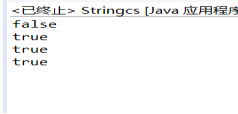04-課堂作業總結歸納
1、請運行以下示例代碼StringPool.java,查看其輸出結果。如何解釋這樣的輸出結果?從中你能總結出什麽?
源代碼:
public class StringPool {
public static void main(String args[])
{
String s0="Hello";
String s1="Hello";
String s2="He"+"llo";
System.out.println(s0==s1);//true
System.out.println(s0==s2);//true
System.out.println(new String("Hello")==new String("Hello"));//false
}
}
第一個so==s1和第二個s0==s2比較的都是字符串的內容(java語言定義“+”運算符可用於兩個字符串的連接操作),所以是true。第三個用new創建了兩個對象,當直接使用new關鍵字創建字符串對象時,雖然值一致(都是“Hello”),但仍然是兩個獨立的對象。
2、

為什麽會有上述的輸出結果?從中你又能總結出什麽?
給字串變量賦值意味著:兩個變量(s1,s2)現在引用同一個字符串對象“a”!
String對象的內容是只讀的,使用“+”修改s1變量的值,實際上是得到了一個新的字符串對象,其內容為“ab”,它與原先s1所引用的對象”a”無關,所以,s1==s2返回false;
代碼中的
String.equals()方法可以比較兩個字符串的內容。
3、請查看String.equals()方法的實現代碼,註意學習其實現方法。
源代碼:
public class StringEquals {
/**
* @param args the command line arguments
*/
public static void main(String[] args) {
String s1=new String("Hello");
String s2=new String("Hello");
System.out.println(s1==s2);
System.out.println(s1.equals(s2));
String s3="Hello";
String s4="Hello";
System.out.println(s3==s4);
System.out.println(s3.equals(s4));
}
}

4、String類的方法可以連續調用:
String str="abc";
String result=str.trim().toUpperCase().concat("defg");
請閱讀JDK中String類上述方法的源碼,模仿其編程方式,編寫一個MyCounter類,它的方法也支持上述的“級聯”調用特性,其調用示例為:
MyCounter counter1=new MyCounter(1);
MyCounter counter2=counter1.increase(100).decrease(2).increase(3);
public class MyCounter
{public static void main(String[] args)
{ String s="aqz";
String result=s.trim().toUpperCase().concat("qwe");
System.out.println(result);
}
}
5、整理String類的Length()、charAt()、 getChars()、replace()、 toUpperCase()、 toLowerCase()、trim()、toCharArray()使用說明
Length():獲取字串長度
charAt():獲取指定位置的字符
getChars():獲取從指定位置起的子串復制到字符數組中
replace():子串替換
toUpperCase()、 toLowerCase():大小寫轉換
trim():去除頭尾空格
toCharArray():將字符串對象轉換為字符數組
length():public int length()//用來求字符串長度
String s=”dwfs”;
System.out.println(s.length());
charAt():public charAt(int index)//index 是字符下標,返回字符串中指定位置的字符
String s=”Hello”;
System.out.println(s.charAt(3));
getChars():public int getChars()//將字符從此字符串復制到目標字符數組
String s= "abc";
Char[] ch = new char[8];
str.getChars(2,3,ch,0);
replace():public int replace()//替換字符串
String s=”****”;
System.out.println(s.replace(“****”,”***”));
toUpperase():public String toUpperCase()//將字符串全部轉換成大寫
System.out.println(new String(“hello”).toUpperCase());
toLowerCse():public String toLowerCase()//將字符串全部轉換成小寫
System.out.println(new String(“HELLO”).toLowerCase());
trim():public String trim()//是去兩邊空格的方法
String x=” a bc ”;
System.out.println(x.trim());/
toCharArray(): String x=”abcd”;// 將字符串對象中的字符轉換為一個字符數組
char myChar[]=x.toCharArray();
System.out.println(“myChar[1]”+myChar[1]);
04-課堂作業總結歸納
